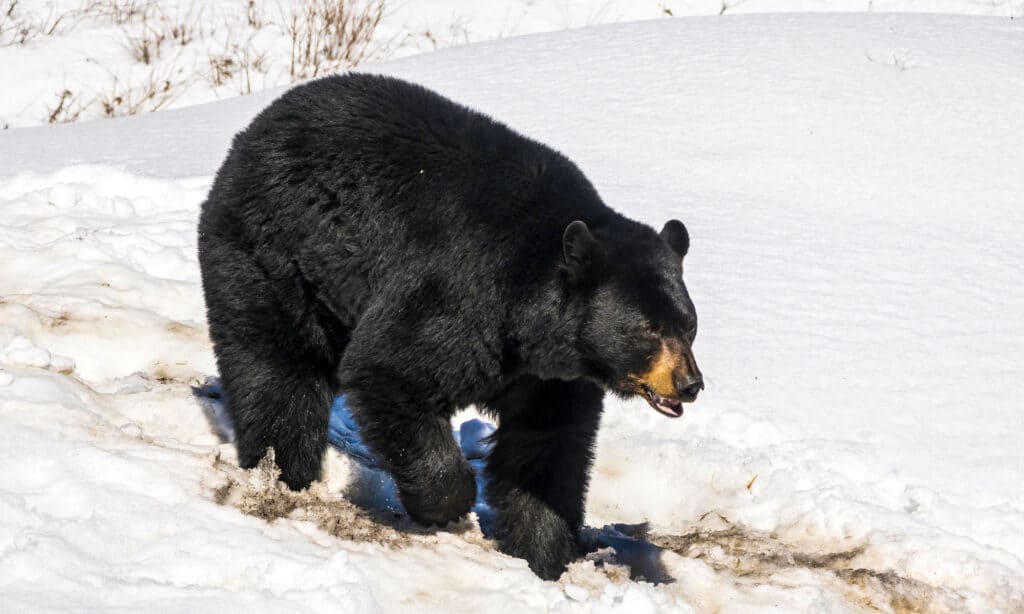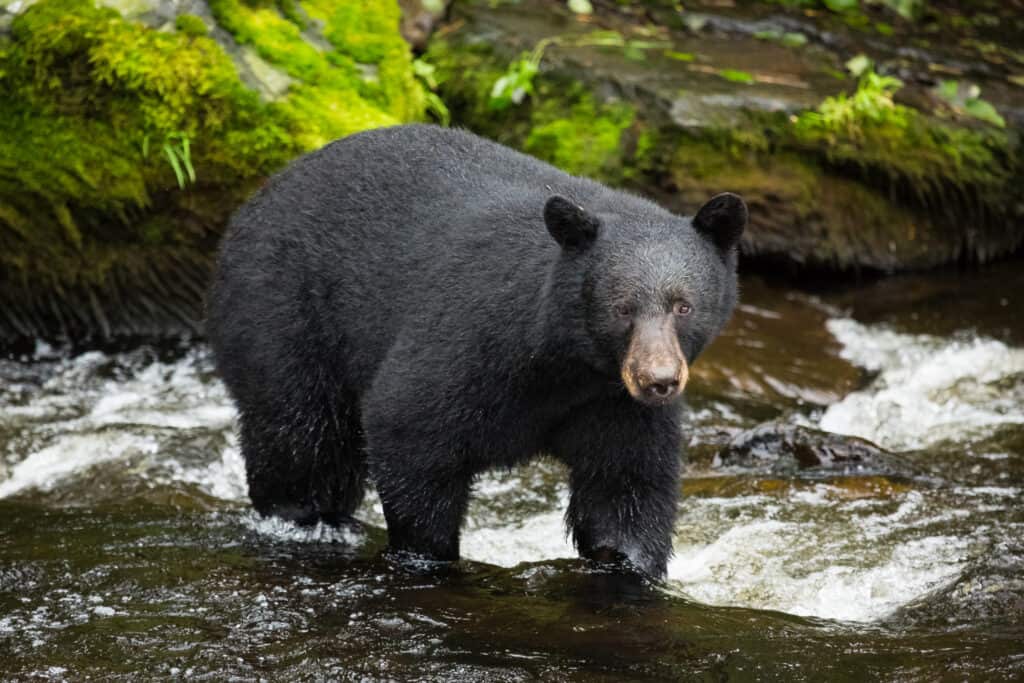Ohio may only rank as the 34th-largest state in the US, but it’s the seventh-most populous and 10th-most densely populated. While the Buckeye State gets its name from Ohio buckeye trees, Ohio is mostly famous for its industries, sports, and major metropolitan center. Yet, you can find various plants and animals in Ohio, including bears. Although settlers wiped out the native bear population by 1851, bear sightings have been rising recently. Let’s discover the largest bear ever caught in Ohio!
The Largest Bear Ever Caught in Ohio

There are currently no records stating which is the largest bear ever caught in Ohio.
©Josef Pittner/Shutterstock.com
The largest bear ever caught in Ohio remains up for dispute. Early settlers killed all of the native black bears in the state by 1850. Few records exist describing the size of the bears killed at that time. As a result, no one can say which bear ranks as the largest bear ever caught in Ohio. However, although black bears disappeared from Ohio for many years, sightings of bears in Ohio are on the rise.
In recent years, one of the largest known bears caught in Ohio died in a traffic collision near Marlboro Township. Around 10pm on August 19th, 2009, a 17-year-old motorist struck a black bear when it ran in front of his car. The motorist was not harmed, but the 250-pound black bear died at the scene. Most black bears killed in Ohio die from traffic collisions as they attempt to cross roads. Several other accounts exist of bears dying in auto accidents across the state. However, most accounts neglect to provide the size of the bear killed in the collision.
In 2020, photos circulated of a bear that supposedly died outside Bainbridge, Ohio. The giant black bear weighed approximately 633 pounds, making it well above average for a black bear. However, it turns out that the bear actually died in Potter County, Pennsylvania. This type of misinformation is common in reports of bear sightings or deaths, as people like to exaggerate stories and sensationalize news about giant predators.
Bears in Ohio: Types and Appearance
Historically, American black bears (Ursus americanus) used to roam throughout much of Ohio. You can find other bears in North America, including grizzly bears and polar bears. That said, neither grizzly or polar bears ever lived in the Buckeye State.
Black bears vary in length and weight depending on their age, sex, and time of year. Most adults range between 90 and 500 pounds, but enormous specimens can top 700 pounds. The average black bear sighted in Ohio measures on the smaller side, with most weighing around 200 pounds. Black bears typically measure three to five feet long and can reach seven feet tall when standing on their hind legs. As their name implies, most black bears possess a thick black coat and a brown muzzle. However, some black bears appear dark brown, cinnamon, blonde, or blue-gray.
Bears in Ohio: Habitat

Black bears prefer to live in mixed and coniferous forests where there are plenty of places to build their dens.
©SCStock/Shutterstock.com
You can find American black bears throughout much of North America. The densest concentrations of black bears occur in Canada, Alaska, and the western, eastern, and northern United States. That said, you can also find smaller populations in the southeastern and southwestern United States and parts of Mexico. Most sightings of black bears in Ohio occur in the eastern part of the state. In particular, people living near Ohio’s northeastern border with Pennsylvania report the most black bear sightings.
Black bears prefer to live in mixed and coniferous forested areas with many trees they can use to climb or make their dens. You can also occasionally find black bears in wetlands, riparian zones, and areas with thick vegetation. They tend to avoid arid regions, deserts, or densely populated areas. However, black bears sometimes wander into human settlements in search of food. Their curious nature and insatiable appetites mean that most sightings happen near campsites, orchards, farms, and garbage dumps.
Are There Many Bears in Ohio?
Before the arrival of settlers in 1788, black bears used to live throughout Ohio. No one knows how many bears lived in the state then, but the total population likely numbered in the thousands or tens of thousands. After settlers killed them all, the population of black bears in Ohio remained zero for over a hundred years. Gradually, black bears started to return to the state thanks to increased efforts to preserve natural habitats. The black bears currently living in Ohio likely migrated from neighboring states such as West Virginia, Kentucky, or Pennsylvania. Presently, the Ohio Department of Natural Resources estimates that 50 to 100 black bears reside in Ohio. Given their low number, Ohio classifies American black bears as an endangered species. However, with a total North American population of 800,000, the IUCN lists American black bears as a species of Least Concern.
Can You Hunt Bears in Ohio?
In the 18th and 19th centuries, no laws existed to restrict the hunting of black bears in Ohio. As a result, settlers killed all of the state’s native bears in the span of a few decades. Due to their extirpation, the Ohio legislature decided to protect any bears that made their way back to the state. Given their endangered status, hunting or knowingly killing a bear in Ohio is illegal. Ohio classifies the purposeful harming of a bear as a first-degree misdemeanor. Those found guilty of willingly hurting a bear can face a $1,000 fine and a jail sentence.
Are Bears Dangerous?

Bears are extremely dangerous and have long, sharp claws and many teeth.
©Elizabeth Caron/Shutterstock.com
There is no such thing as a safe wild animal. Although they may look cute and cuddly, bears possess all the tools necessary to kill a human. Even a small American black bear can easily hurt or fatally wound a person. With their long claws, strong jaws, and powerful bodies, even the strongest people stand no chance unarmed against a motivated adult black bear. Luckily, most black bears want little to do with humans and typically avoid densely populated areas. A bear is likely more afraid of you than you are of it. However, bears that live in close proximity to humans can slowly lose their fear of people. Additionally, a hungry bear may attack if you come between it and food, and mother bears can charge if you separate them from their cubs.
If you encounter a black bear in the wild, remain calm. Try to make yourself appear as large as possible by waving your arms above your head. In the event a bear comes close to you, make loud noises to try and drive it off. Always maintain eye contact with a wild bear and never turn your back or run away from a bear. Additionally, black bears scavenge for food, so you should not play dead around a black bear. If you do, the bear may mistake you for an easy meal and wander over to take a bite out of you. To protect yourself against black bear attacks, consider carrying a can of bear mace with you when walking through areas with frequent bear sightings. All that said, your chances of getting attacked or killed by a bear number around 1 in 2.1 million.
Conclusion
The debate continues concerning the largest bear ever caught in Ohio. Although bears disappeared from the state for over 100 years, bear sightings increase yearly. Today, approximately 50 to 100 black bears live throughout the eastern part of the state. While most of these bears are on the smaller side, a few giant bears may yet roam the Ohio countryside.
Up Next
- Discover the Largest Bear Ever Caught in Oregon
- 5 Massive Bears Larger Than a Grizzly
- Discover the Largest Bear Ever Caught in Michigan
- The Largest Black Bear in History
- Discover the Largest Grizzly Bear Ever!
The photo featured at the top of this post is © SCStock/Shutterstock.com
Sources
- , Available here: https://www.cleveland.com/metro/2009/08/black_bear_killed_in_runin_wit.html
- , Available here: https://www.cleveland19.com/2019/06/07/theres-bears-them-there-woods/
- , Available here: https://ohiodnr.gov/discover-and-learn/animals/mammals/black-bear
- , Available here: https://www.ohiowildlifecenter.org/black-bear-returning/
Thank you for reading! Have some feedback for us? Contact the AZ Animals editorial team.






